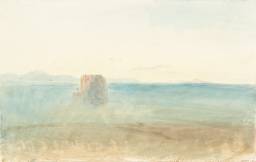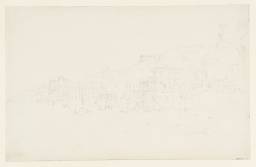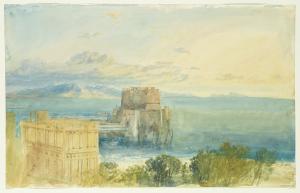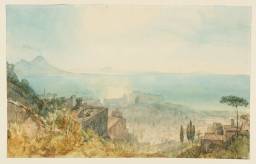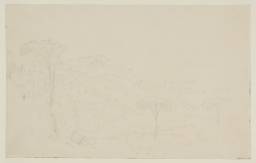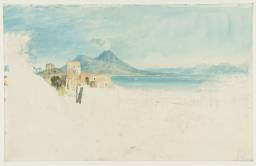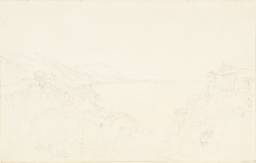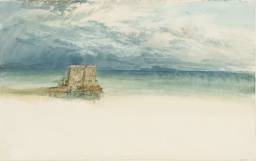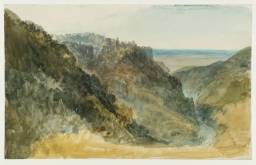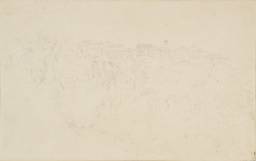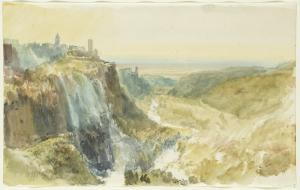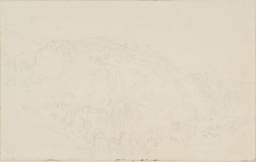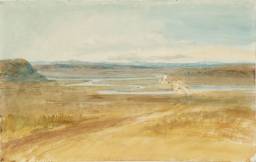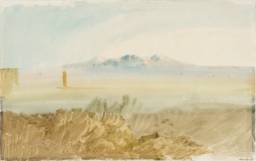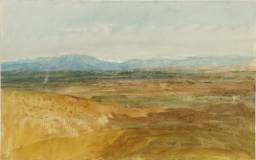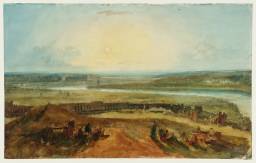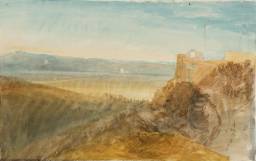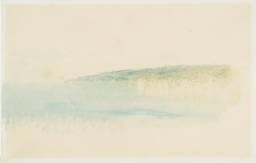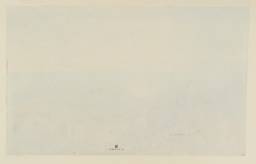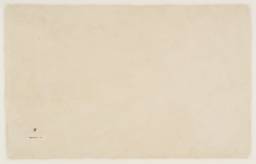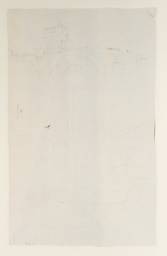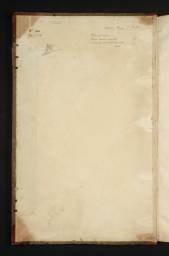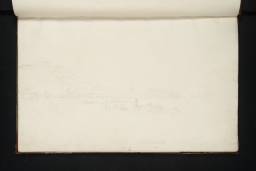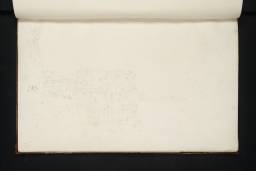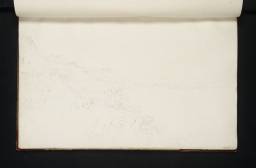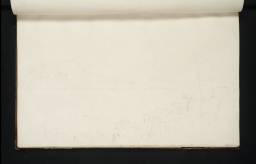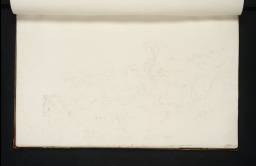Turner Bequest CLXXXVII 1–69
Sketchbook with paper covered boards bound with a tan leather spine and corners, and two brass clasps [missing]
70 leaves of two types of white wove writing paper, approximate page size 406 x 255 mm. See technical notes below.
70 leaves of two types of white wove writing paper, approximate page size 406 x 255 mm. See technical notes below.
Inside front cover (D41405) is inscribed by the artist in pencil ‘[?Poule] della [?Corla]’ top left, ascending left-hand edge
Numbered ‘144’ as part of the Turner Schedule in 1854 and endorsed by the Executors of the Turner Bequest, inscribed in black ink ‘No.144 | [?Gio fireces]’ and initialled in pencil by Charles Lock Eastlake ‘C.L.E.’ and John Prescott Knight, ‘JPK’
Inscribed by unknown hands in pencil ‘L 14’ and ‘CLXXXVII’ top left and ‘Naples: Rome. C Studies | Rebound 1935 | Blank leaves inserted | indicating mounted drawings | AMH’ top right
Numbered ‘144’ as part of the Turner Schedule in 1854 and endorsed by the Executors of the Turner Bequest, inscribed in black ink ‘No.144 | [?Gio fireces]’ and initialled in pencil by Charles Lock Eastlake ‘C.L.E.’ and John Prescott Knight, ‘JPK’
Inscribed by unknown hands in pencil ‘L 14’ and ‘CLXXXVII’ top left and ‘Naples: Rome. C Studies | Rebound 1935 | Blank leaves inserted | indicating mounted drawings | AMH’ top right
Inside back cover (D41407) is inscribed by the artist in pencil ‘[Sta] Pall Cheava | Ceva | Forum Trajans’ top right
Accepted by the nation as part of the Turner Bequest 1856
Exhibition history
References
Turner used this sketchbook during his first tour of Italy in 1819, one of twenty-three related to that trip. The book contains studies of various subjects in Rome, Tivoli and Naples, some of which are pencil drawings on white paper, whilst others are executed over a washed grey background or are coloured or partially coloured with watercolour. The title of the book follows Turner’s own handwritten label ‘15. Naples. Rome C. Studies’ (see D41404).
The ‘C’ in the title of this sketchbook, and the Rome C. Studies and Small Roman C. Studies sketchbooks, has been frequently interpreted in the past as meaning ‘Colour’, referring to the use of watercolour to develop some of the studies within. Alternatively, as Finberg believed, it may stand for ‘Chiarascuro’, reflecting the numerous tonal drawings employing pencil and white highlights over a washed grey background.1 More recently, Cecilia Powell has plausibly suggested that the ‘C’ might also be interpreted as ‘Composition’, since all of the relevant books contain carefully structured designs which could be intended for further development, or which relate to later watercolours and oils.2 Many of the studies repeat or develop subjects recorded in other sketchbooks, but with a greater level of artistic expression and attention to detail. For example, views of Pozzuoli and the Bay of Baiae (D16103 and D16105; Turner Bequest CLXXXVII 15 and 17), clearly build upon on-the-spot sketches from the Gandolfo to Naples sketchbook (Tate D15667 and D15668; Turner Bequest CLXXXIV 55a–56), whilst the watercolour study of Rome from Monte Testaccio closely mirrors a drawing in the Rome and Florence sketchbook (see Tate D16497; Turner Bequest CXCI 7a). However, the only subject from the Naples. Rome C. Studies sketchbook which can be directly linked to a finished composition is a view of the Bay of Naples (Tate D16101; Turner Bequest CLXXXVII 13), which formed the basis for Bay of Naples, with Vesuvius – Morning 1820 (whereabouts currently unknown), purchased by Walter Fawkes (1769–1825).3 Perhaps most surprising, given the large number of studies devoted to the place, is Turner’s failure to complete any finished pictures of Tivoli until his vignette illustration for Rogers’s Italy, nearly ten years after his visit (Tate D27683; Turner Bequest CCLXXX 166).
In his polemical publication Modern Painters (1843), John Ruskin argued that Turner’s mode of treatment depended on the nature of the subject. Particularly interesting in the Naples. Rome C. Studies sketchbook is the way in which the artist interchanged his media, paper and style according to his artistic response to different locations. The coloured studies of Naples, for example, use the purest, limpid washes of watercolour, particularly blue, to describe the luminous quality of warm, southern light and the special relationship between sea and sky in the idyllic scenery of the Bay of Naples (see for example D16089, D16093, D16101, D16106, D16109; Turner Bequest CLXXXVII 2, 6, 13, 18, 21). Turner’s use of watercolour in the two Tivoli compositions meanwhile, is much more textural and layered, depicting the lush and verdant landscape of the hills surrounding the town (see Tate D16116 and D16120: Turner Bequest CLXXXVII 28 and 32). Poised between these two approaches are the paintings of the outskirts of Rome where wide, clear expanses of sky contrast with the hills and plains of the Roman Campagna (D16122, D16123, D16129, D16130, D16131, D16133; Turner Bequest CLXXXVII 34, 53, 41, 42, 43, 45). Aside from the coloured and tonal studies, the book is comprised of detailed pencil drawings which combine topographical accuracy with aesthetic refinement. Ruskin described the views of Rome and Naples as the ‘most exquisite drawings left unfinished in the collection’ and described them as compositions which Turner had ‘outlined accurately on pure white paper, begun in the middle of the sheet, and worked out to the side, finishing as he proceeds.’4 For a related discussion of Turner’s Italian colour studies see the introduction to the Rome C. Studies sketchbook (Tate; Turner Bequest CLXXXIX).
Ibid., p.562. See also Andrew Wilton’s entry in J.M.W. Turner, à l’occasion du cinquantième anniversaire du British Council, Galeries nationales du Grand Palais, Paris, October 1983–January 1984, pp.218–20.
Technical notes
How to cite
Nicola Moorby, ‘Naples, Rome C. Studies sketchbook 1819’, sketchbook, March 2009, in David Blayney Brown (ed.), J.M.W. Turner: Sketchbooks, Drawings and Watercolours, Tate Research Publication, December 2012, https://www

